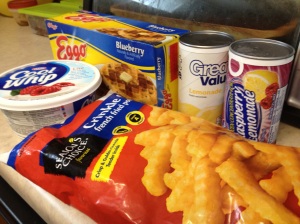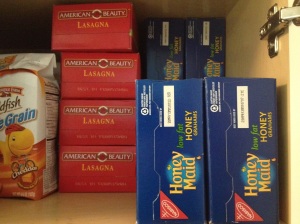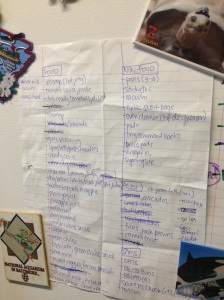You’ve spent time Preparing to Price Match, shopping & Price Match saving in the store and now you’re home. What to do? Make sure your front-end hard work and savings are maintained as you’re storing and using the items in your home. By using these simple strategies, you’ll make great use of your groceries, optimize food usage and find smart savings success.
Keep Item Categories Together In The Store.
As I’m placing the items for the cashier, I take time to sort the items together by category. I try to keep my breads, frozen foods, fresh foods, canned items, meats and cheeses together. And it usually saves me time in the end, because I’m able (for the most part) to come home and the items are usually grouped by category in the bags too. Try this as you’re shopping and purchasing your items, it should make it easier for you as well.
Sort Items Into Areas When You Get Home.
Once I’m home and unloading the groceries, at first, I simply divide them into piles based on where they need to go. Frozen items are grouped on the counter by the freezer. Boxed/Packaged items are placed in front of our pantry and cleaning supplies stay on the stairs. All of these items are easier to put away when I can do the whole category at one time. When you start by grouping your items, it makes putting everything away much faster.
Put Items Away In The Correct Order.
It’s rare that I can put all of the groceries away immediately when I get home (remember, always prepare for interruptions), so I always put my items away in the order listed below. By starting with the most perishable foods, I ensure that at least these items are put away and I can come back to unloading the groceries as I have time. It helps that I’ve already sorted my items into categories too–this way I know for sure that I’ve been able to put away all of the perishable items first and that the other items are a grouped and in a temporary active storage area ready to be put away.
- Freezer/Deep Freeze
- Refrigerator
- Fresh “Countertop” Food
- Packaged Food
- Storage
- Non-Food Items (keep cleaners and chemicals out of reach of children)
Use Oldest Items First.
All of your packages are marked with expiration dates. As you put your items away, put the closest expiration date at the front. Do this every time and when you grab an item to use, you’ll be confident that it’s the right item at the right time. The dates for each item are listed on the boxes (you can see the white box on the graham crackers and the faint white text on the lasagna noodles), keep the dates visible, if this will help your organization.
Store Like Items Together.
As you put your groceries away, take time to store similar items in the same area (and always store the newest items at the back). By keeping all of your peanut butter or condensed soup in one area, you’re less likely to run out, and more importantly, less likely to over buy. And a tip that I learned the hard way, if you have a pantry like this (a re-purposed towel cabinet), store all of the heavy items on the bottom–most sturdy–shelf.
Keep Frequently Used Items Accessible.
We use our spices for nearly every meal and it’s important to be able to find the right item when I need it. I have three categories for my spice cabinet.
- The bottom shelf is cooking supplies: savory spices, flavorings, sauces, seasonings and extras (like breadcrumbs)
- The middle shelf is baking supplies: sweet spices, drink mixes, jello packets, sprinkles and honey
- The top shelf is baking extras and ingredients: chocolate chips, food coloring, shortening, icing and cake mixes
By keeping our similar items together and these daily use items accessible, it’s easy to add flavor to our dishes and find these items when I need them. Try organizing your spices and extras in a system that works for you. It could be alphabetical, by category or by frequency of use.
Use Your System to Keep Your Kitchen Fully Stocked.
As we run out of needed items, I put everything on our master grocery list that’s on our fridge door. This helps me remember needed items when Price Matching sales are active and keeps me from overbuying items in the store–because I stick to the list.
I actually love to put away groceries, because it means I get to re-organize our cabinets, pantry, fridge, freezer/deep freeze every time I go shopping. And I always follow the strategies listed above. We’ve begun to save more (I’ve saved about 50% on our bill), we throw away less (about 50% less) and now that I have my system down, it’s easy to keep it going!
Tip! Try to limit your grocery shopping to once a week or less. If you find you’re running to the store for one item regularly, you’re wasting time. Plan to only go shopping when you need to and teach your family to do without until the next scheduled shopping trip. We make 3-4 grocery trips each month on average.







[…] Great Groceries: Storage Systems That Work. […]
[…] similar items together. Storing similar items together in labeled baskets or containers makes grab-and-go items much easier and more manageable when […]
[…] foods on the weekends or when you have time. I spend 1-2 hours every weekend organizing groceries or prepping food & snacks for the week. I rotate foods from my deep freeze to my freezer and […]
[…] your meals around your freshest foods. I love grocery day. I get to organize the groceries to make it fit perfectly, but more importantly, we also get all the new, fresh foods. […]
[…] this by checking expiration dates of items as you purchase them (and always buy the item with farthest expiration date). Recently I purchased 10 jars of pasta […]